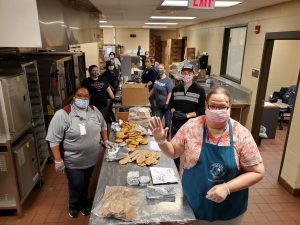School meals are a vital source of federal food assistance; the National School Lunch and School Breakfast programs serve approximately 30 million lunches and 15 million breakfasts daily at low or no cost to students. At the start of the COVID-19 pandemic in March, schools closed across the country, leaving millions of children without access to the school meals they rely on to meet their nutritional needs. A team of researchers, including Dr. Eliza Kinsey with Columbia University’s Social & Spatial Epidemiology Unit, recently published a study in the American Journal of Public Health documenting the disruption to school meals as a result of COVID-related school closures. The authors estimate that more than 1.15 billion breakfasts and lunches for students in the U.S. who receive free and reduced-price meals were not served in school as a result of school closures during the nine-week period between March 9 and May 1.

Preparing school meals during the pandemic – Somerset County
In Maryland, which the researchers studied in depth, every day schools were closed, nearly 500,000 free or reduced-price meals were not served in school (the equivalent of almost 2.5 million meals per week). While Maryland estimates that by the week of April 20, they were distributing 1 million replacement meals to students weekly, this still represents a roughly 1.5 million meal weekly shortfall. Similarly, major cities like New York City, Philadelphia, and San Francisco provided far fewer meals than they would have if schools were open.
These shortfalls come despite major efforts at the federal, state and local level. The authors highlight the strategies that states and school districts are using to replace these missed meals, enabled in large part by 18 nationwide waivers from the U.S. Department of Agriculture intended to increase meal program flexibility and allow for innovation in meal service during the pandemic. In many districts, this has included serving meals in a grab-and-go format at centralized, outdoor locations and offering a week’s worth of meals at one time. Some districts, particularly in rural locations, have provided home delivery or distributed meals along school bus routes.
Lastly, the authors explore lessons learned from the pandemic with the goal of informing and strengthening future school nutrition policies. The challenges school nutrition operators face in keeping children fed during the pandemic highlight preexisting hurdles associated with running school nutrition programs when schools are not in session, and the pandemic can provide many useful lessons for future out-of-school meal provision.
All of the authors of this publication are members of the ad hoc COVID-19 School Nutrition Implications Working Group, jointly supported by Healthy Eating Research (HER), a national program of the Robert Wood Johnson Foundation (RWJF), and the CDC’s Nutrition and Obesity Policy Research and Evaluation Network (NOPREN). This project was supported by funding from NOPREN.

